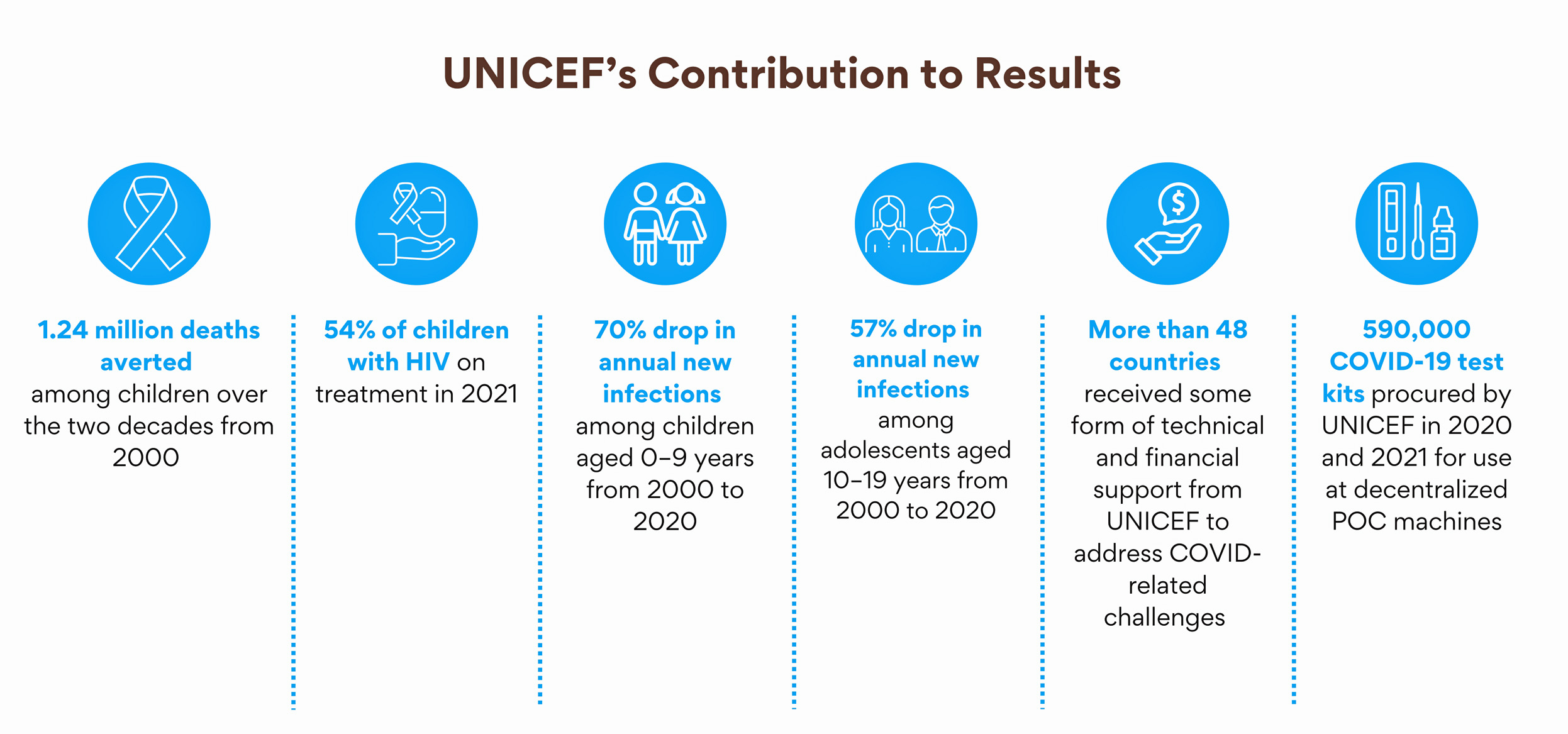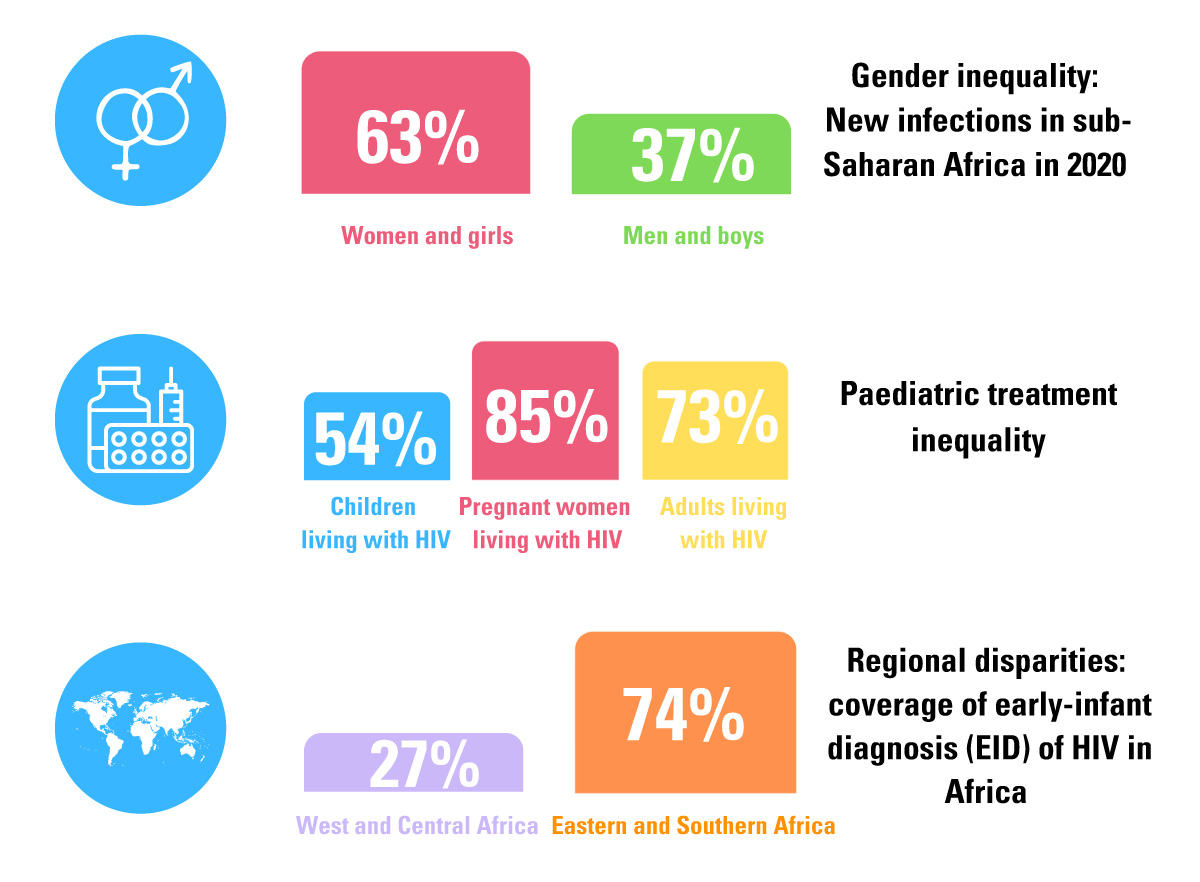2023 Global and Regional Snapshots on HIV and AIDS: Progress and priorities for children, adolescents and pregnant women
UNICEF's annual global and regional epidemiological and response snapshots of Eastern and Southern Africa, West and Central Africa, and the Middle East and North Africa, based on the UNAIDS 2023 HIV estimates.
The snapshots describe where we are in terms of vertical transmission, the treatment gap, and the impact on adolescents.
Understanding Viral Load Suppression Trends (2017-2020) for Children Living with HIV in Eastern and Southern Africa
In 2022 an estimated 930,000 children (aged 0-14 years) were living with HIV in Eastern and Southern Africa. Nearly one-third of these children were not receiving lifesaving treatment. Children with HIV need both antiretroviral treatment and viral load suppression if they are to lead long and healthy lives.
UNICEF, in collaboration with governments and partners, supported an updated analysis of laboratory information management systems (LIMS) data in Malawi, Uganda and Zimbabwe from 2017-2020 to better understand viral suppression among children, especially in the context of WHO recommendations for newer, more efficacious drug regimens and the COVID-19 pandemic.
A previous analysis of 2016-2018 LIMS data found that one in every three children was not virally suppressed. The updated study found a steady increase since then in viral load testing, the use of more efficacious and palatable antiretroviral regimen options, and improved viral load suppression. However, children are still falling short of global targets to end AIDS by 2030. The full report describes the methodology, key findings, limitations, and proposes further prioritization and accelerated action to improve treatment outcomes for children with HIV.
Global Annual Results Report 2022: Goal Area 1
UNICEF continues to play a critical role in driving progress toward the end of HIV and AIDS among children, adolescents and pregnant women. In 2022, together with partners across sectors, UNICEF advanced the quality and scope of programming for HIV prevention, treatment and care while mitigating the impact of challenges – such as COVID-19 – to the availability of and access to HIV services.
UNICEF’s HIV programme is guided by the UNICEF Strategic Plan for 2022–2025. The 2022 Global Annual Results Report for Goal Area 1 presents results in fast-tracking the end of HIV and AIDS as well as the results for interconnected programmes in health, nutrition, and early childhood development.
See an excerpt focused on HIV in the following viewer and download the full 2022 Global Annual Results Report: Goal Area 1 document below.
To learn more about UNICEF’s HIV programme, visit www.unicef.org/hiv.
Global Annual Results Report 2021: Every child survives and thrives: HIV and AIDS
It is clear that the AIDS epidemic is not over. The pace of progress is too slow to meet the 2030 SDG targets. To promote faster and more consistent improvement, the new UNICEF Strategic Plan emphasizes differentiation, integration, partnership and innovation to address barriers to inequalities.

Reasons for stalled progress in 2021:
Inequalities that are leaving too many behind:

Cash Plus: An Adolescent Livelihood, Health and Well-being Intervention as part of Tanzania’s Productive Social Safety Net Programme
For adolescent boys and girls, transitioning to adulthood means facing significant social, health and economic risks. These include a lack of economic opportunities, early marriage and pregnancy, sexually transmitted infections including HIV, violence, abuse and exploitation. To support a safe, healthy and productive passage to adulthood, the Tanzania Social Action Fund (TASAF), the Tanzania Commission for AIDS (TACAIDS), UNICEF and other key stakeholders have developed, implemented and evaluated an intervention where social protection and economic empowerment interventions are combined with sexual and reproductive health education and services as part of the Tanzanian government’s cash transfer programme, the Productive Social Safety Net (PSSN).
The resources available include a project brief with a summary of the programme components and impact evaluation, as well as research briefs and reports from the baseline, midline and third wave of data collection.
HIV Couples Testing in Rwanda
An opportunity to reshape gender norms on sexual and reproductive health in Rwanda: Learning from a pilot project on male partner self-testing for HIV. Rwanda conducted a research study on using self-testing and other means to improve male partner testing and engagement in PMTCT.
HIV - Sensitive Social Protection: What does the evidence say?
This paper reviews the 2010 state of the evidence on the contribution of social protection to HIV prevention, treatment, care and support, as well as protection of key populations at higher risk of infection.
HIV-Sensitive Social Protection: State of the evidence 2012 in sub-Saharan Africa
This review provides a conceptual framework for HIV-sensitive social protection policies and programmes and review the impact of social protection on HIV prevention and treatment outcomes in addition to social and economic care and support. It further provides recommendations for achieving core HIV impacts, comprehensive approaches, and expanding and sustaining HIV-sensitive social protection.